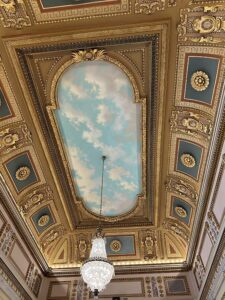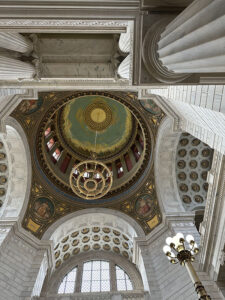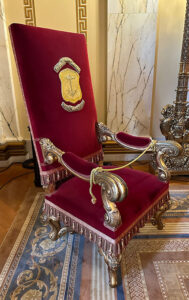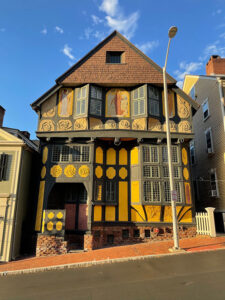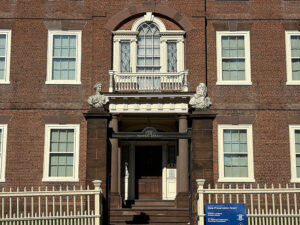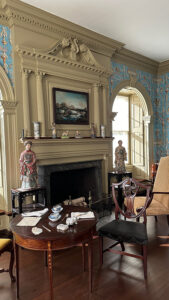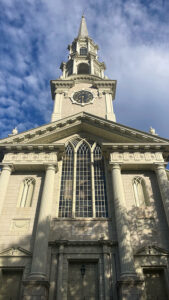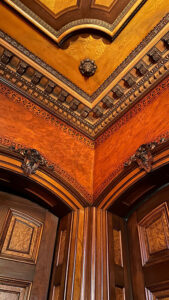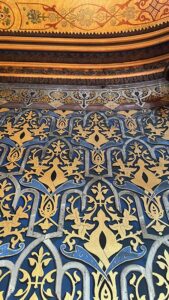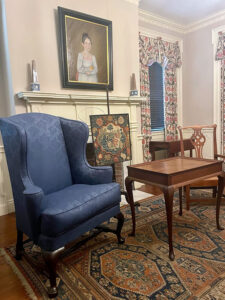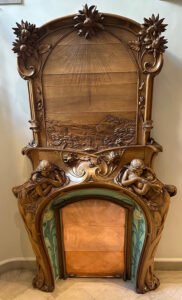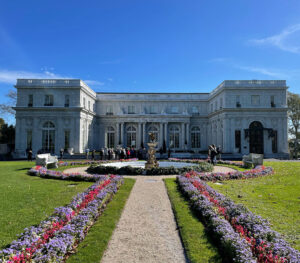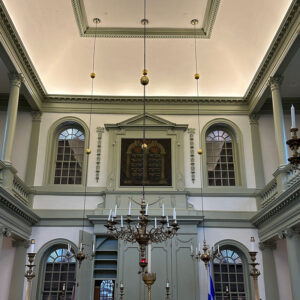Refined Rhode Island: Providence and Newport Examined
EVENTS > SYMPOSIA
DECORATIVE ARTS TRUST FALL SYMPOSIUM
October 25–29, 2023
Join us in Rhode Island for an exciting survey of noteworthy architecture and collections in Providence and Newport. Both cities feature an impressive array of sites and museums covering the Colonial era through present day. This gathering promises to provide a splendid selection of tours and lectures for our enjoyment. Working with our colleagues at the Rhode Island Historical Society, Preservation Society of Newport County, the Newport Restoration Foundation, and the Rhode Island School of Design, we will have special access to all of the top highlights in these magical cities.
REGISTRATION NOW CLOSED
SYMPOSIUM SCHEDULE
Thursday, October 26
Opening Night at the Corliss-Carrington House
5:30 pm–9:00 pm
- Welcoming Remarks and Opening Program
- The Jonathan L. Fairbanks Lecture
Picturing Providence and the Cultural Landscape of College Hill
Robert P. Emlen, Visiting Scholar in American Studies, Brown University - Opening Reception
Sponsored by:
Friday, October 27
College Hill and Benefit Street
9:00 am–5:00 pm
- Providence Defined: The Architectural Development of Rhode Island’s Capital
John Tschirch, Architectural Historian - After our morning lecture sets the stage for our exploration of Providence, our first stop is the resplendent Rhode Island State House, a Neo-classical McKim, Mead & White building constructed of gleaming white Georgia marble. Finished in 1901, the capitol houses a magnificent rotunda leading to Senate and House Chambers and the State Library with a ceiling designed to resemble a leather-bound book. The exterior boasts one of the largest self-supporting domes in the world. We then delve into Providence’s storied history with a visit to the Providence Athenaeum. Having accumulated books and objects for over 200 years, the Athenaeum’s special collections have tracked developments in art and collecting from the institution’s founding to the present. After lunch, our afternoon features three visits in Providence’s College Hill and Benefit Street neighborhoods. The 1865 Lippitt House was built by one of Rhode Island’s leading textile manufacturing families. An outstanding example of Renaissance Revival architecture, the house is preserved in remarkably intact condition with elaborate paint-decorated walls and ceiling finishes, stained-glass windows, and ornate plaster and carved wood- work details. A walking tour of Benefit Street, Providence’s Mile of History, will allow us to examine one of the most extensive collections of 18th-and 19th-century architecture in the country. John Tschirch will share how this street developed as a dense mix of civic, educational, cultural, and religious institutions interspersed with historically significant residences. Noted by John Quincy Adams to be “the most magnificent and elegant private mansion… on this continent,” the John Brown House was the first large home built in Providence. It was constructed and named for the co-founder of Brown University, a prominent statesman and slave trader. The commanding house is now under the auspices of The Rhode Island Historical Society, an organization dedicated to preserving the house’s collections and overseeing a strategic reinterpretation project.
Saturday, October 28
Providence’s Artistic Heritage
9:30 am–5:00 pm
- Gorham Silver: Designing Brilliance in Providence
Elizabeth A. Williams, PhD, David and Peggy Rockefeller Curator of Decorative Arts and Design, RISD Museum - 1900 to Now: Artist Commissions and Collaborations
Emily Banas, Assistant Curator, Decorative Arts and Design, RISD Museum - Radical Imaginings of Evidence: Slavery and Architectural Refusal of the Speculum Oris in The Providence Market House
Christopher G. Roberts, PhD, Assistant Professor, Department of Theory, History of Art and Design, Rhode Island School of Design - After the morning lectures, we dine in the galleries of the Providence Art Club and then venture for a trio of outings taking in a full array of Providence’s past, from the 18th to the 21st centuries. Tours of the Art Club’s buildings will demonstrate the development of domestic architecture from the 1784 Deacon Edward Taylor House to the distinguished 1885 Tudor Revival Fleur-De-Lys Building, a historic studio important to the development of the Arts and Crafts Movement in the United States. Founded by a tightly-knit community of artists and collectors in 1880, the club now administers four historic houses on Thomas Street. We then move to the campus of the Rhode Island School of Design, one of the nation’s first and best-known studio and design colleges. The RISD Museum welcomes us for exclusive curator-led tours of their re-envisioned decorative arts galleries. Their ambitious new Art and Design from 1900 to Now exhibition draws together works on paper, costume and textiles, painting, sculpture, photography, and decorative arts and design, to reflect the interconnectedness of the disciplines RISD teaches and the cross pollination among art forms and media that can influence how artists work. Also under the RISD Museum’s purview is the Pendleton House, designed by Providence architectural firm Stone, Carpenter and Willson for the purpose of displaying the collection of Charles L. Pendleton. In 1904, Pendleton bequeathed his collection of American and European furniture, silver, glass, ceramics, textiles, and paintings to the RISD Museum. Our special tour of the house will take in these special objects, including the remarkable Martelé Writing Table and Chair by Gorham Manufacturing Company.
Sunday, October 29
Closing Lectures at The Hotel Providence
8:45 am–11:00 am
- The Life of Wallpapers: The Huard Collection at the RISD Museum
Emily Banas, Assistant Curator, Decorative Arts and Design, RISD Museum - John A.H. Sweeney Emerging Scholar Lecture
Indigenous Art: Past, Present, and Future at the RISD Museum
Sháńdíín Brown, Henry Luce Curatorial Fellow for Native American Art, RISD Museum - Seeing Things Differently to Tell Larger Stories: Re-envisioning the John Brown House Museum
Rick Ring, Deputy Executive Director for Collections and Interpretation, Rhode Island Historical Society - An Avian Bequest: Abby Aldrich Rockefeller’s Japanese Prints at the RISD Museum
Wai Yee Chiong, Associate Curator of Asian Art, RISD Museum - Symposium concludes
OPTIONAL TOURS
PRE-SYMPOSIUM OPTIONAL TOUR – NEWPORT’S GLITTERING GILDED AGE
Wednesday, October 25, 8:30 am to Thursday, October 26, 4:15 pm
An early morning departure from Providence permits a full day of touring Newport’s Gilded Age mansions. Our first stop is The Elms, built in 1901 as the summer residence of Mr. and Mrs. Edward Julius Berwind. Architect Horace Trumbauer modeled the house after an 18th-century French château, and the interior furnishings were designed by Allard et Fils of Paris, providing a lovely setting for the Berwinds’ collection of Renaissance ceramics, 18th-century French and Venetian paintings, and Oriental jades. Our next stop is Rosecliff, the 1902 French Baroque Revival mansion commissioned by Theresa Fair Oelrichs. Built from white terra cotta, the house was designed by Stanford White, inspired by the Grand Trianon at Versailles. The interior features a heart-shaped staircase and the largest ballroom in Newport, while the grounds boast gardens overlooking the Atlantic Ocean. We enjoy a special tour with Leslie B. Jones, Director of Museum Affairs and Chief Curator for The Preservation Society of Newport County. The Society also invites us for lunch in Rosecliff ’s newly reopened Dining Room. We progress to The Breakers, the grandest of Newport’s summer “cottages” constructed from 1893–95 and a symbol of the Vanderbilt family’s social and financial preeminence in the Gilded Age. Architect Richard Morris Hunt created a classic Italian palazzo design with 70 rooms, many of which were decorated with the finest materials available, like Baccarat crystal and platinum leaf, as well as utilities such as boilers and electricity. We continue to the Gothic Revival Kingscote, designed by Richard Upjohn and built in 1839 for George Noble Jones. In December 1880, new residents in the King family hired Stanford White of McKim, Mead & White to design an addition, including a new dining room with opalescent glass bricks purchased from Louis Comfort Tiffany. The evening culminates in a reception at Bois Doré, a French château-style mansion built in 1927 designed by Charles A. Platt for William Fahnestock, and a stay at the charming Newport Harbor Island Resort. Thursday’s itinerary features an enviable selection of visits to private homes and gardens that you will not want to miss! En route back to Providence, we stop at Clouds Hill, an 1877 country estate built for Elizabeth Ives Slater Reed as a wedding gift from her father. Built in the Gothic Revival style by Providence architect William R. Walker, the house retains exceptional examples of Victorian-era craftsmanship, including its distinctive Egyptian room.
POST-SYMPOSIUM OPTIONAL TOUR – COLONIAL NEWPORT: A GOLDEN ERA
Sunday, October 29, 11:15 am–8:15 pm
This Optional Tour investigates Newport’s Colonial era, beginning with a delightful lunch followed by a tour at the c. 1739 Colony House, the fourth oldest statehouse in the United States, built in the style of an English town hall. We continue for a rotation of visits along Newport’s 18th century core. The 1763 Touro Synagogue, designed by Peter Harrison, is the oldest synagogue in the country and was built to accommodate a growing Jewish population that began arriving in Newport from Spain and Portugal a century earlier. A Newport resident, Harrison drew upon his knowledge of Palladian architecture for the exterior and was likely guided by the congregation for the execution of the interior. Another Harrison project was the Neoclassical Redwood Library & Athenaeum, the design of which was inspired by a Roman Doric temple with portico and wings. As the country’s oldest secular public cultural institution, the library’s collections date to its founding in 1747 and contain over 200,000 titles and objects with particular strengths in early American history, material culture, architecture, and decorative arts. Among Newport’s most prominent Colonial residences is the exceptional Georgian William Vernon House, whose mid-18th century exterior belies a late 17th century core. Among the most notable interior features is a series of painted chinoiserie murals discovered in the 1930s. Winterthur Professor Emeritus Brock Jobe then guides us through Hunter House, a c. 1748 house with a fabulous collection, recently reopened to the public. A trip to Doris Duke’s Rough Point will provide an opportunity to closely examine the Newport Restoration Foundation’s exceptional collection of colonial furniture and silver. The day ends with a convivial reception at a private home overlooking the Sound.
FUNDRAISER
FUNDRAISER FOR THE EMERGING SCHOLARS PROGRAM AT THE HOME OF JON PAUL COUTURE
Saturday, October 28
6:30 pm–8:00 pm
We are delighted by the invitation to join Trust member JP Couture in his handsomely detailed Italianate townhome for our Emerging Scholars Program fundraiser. Designed by Thomas A. Tefft—one of the country’s first professionally trained architects—the c. 1850, three-story sandstone villa was built for Providence resident Menzie Sweet (1793–1861).
Please join us for a wonderful evening of connoisseurship and conviviality as we toast to our host’s hospitality and lend support to the Trust’s efforts to encourage the next generation of curators and academics through a growing series of grants, scholarships, and internships. In 2023, more than 50 graduate students and young professionals will benefit from the Trust’s Emerging Scholars Program.
A donation of $250 per person and prior registration are required to attend this fundraiser.
TRAVEL, LODGING & ADDITIONAL INFORMATION
ACCOMMODATIONS
The Hotel Providence, 139 Mathewson Street, Providence, RI 02903
Special Room Rates: A block of rooms is reserved for October 24–30 at $189 per night. These rooms are available on a first-come first-served basis until September 24, 2023. Please make your reservations as soon as possible to ensure availability by calling 1.800.861.8990 and referencing the Decorative Arts Trust.
TERMS AND CONDITIONS
Registration fee: $1,175 per person, which includes all lectures, tours, meals, receptions, and transportation referenced in symposium brochure as well as a $50 tax-deductible donation to the Dewey Lee Curtis Scholarship Fund to underwrite symposium scholarships (see below). Participants may elect to make an additional donation through registration.
Student and Young Professional fee: $500 per person, limited to current graduate students and non-profit professionals less than five years from the completion of a degree. The Trust also awards at least two Dewey Lee Curtis Symposium Scholarships for graduate students or young professionals. Applications can be submitted through the Trust’s website and are due by August 31, 2023.
Optional programs: The Pre-Symposium Optional Tour is $650 for a single registration and $1,050 for two participants sharing a room, and includes hotel accommodations at the Newport Harbor Island Resort for the night. The Post-Symposium Optional Tour is $350 per person. The Saturday evening fundraiser for the Trust’s Emerging Scholars Program is $250 per person, fully tax deductible. All fees include transportation, admission, and food and beverage as referenced in the brochure. Registration for optional programs is limited.
Membership: All participants must be members of the Decorative Arts Trust. Visit decorativeartstrust.org/join for membership levels and benefits. Members at the Sponsor level and above are invited to a special event during the Symposium.
Cancellation fees: All cancellations received by August 31, 2023, are subject to a full refund less a $100 administrative fee per person. Participants canceling between September 1 and September 30, 2023, will receive a 50% refund. Refunds will not be made after September 30, 2023.
Itinerary: The schedule, sites, and events outlined in this itinerary are subject to change as necessary.
Participation: The program is limited to a maximum of 75 members. We will organize and maintain wait lists on the basis of the time registrations are received. Participants are expected to take COVID-19 tests and wear masks when requested.

